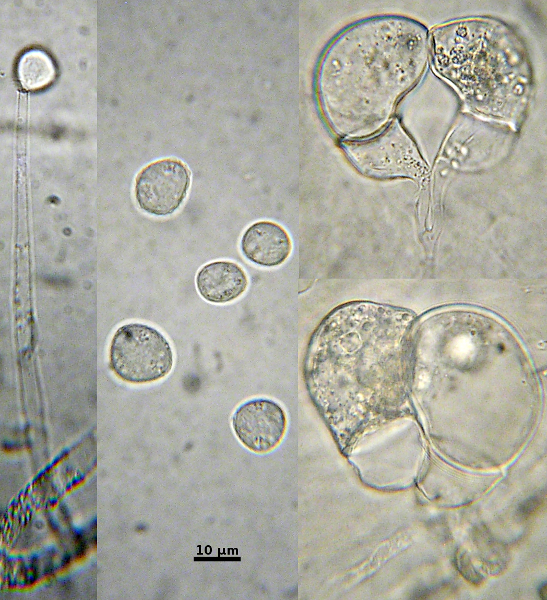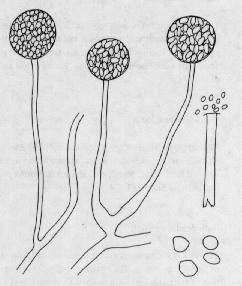Main page <> Index of descriptions <> Previous description <> Mortierella <> Next description
Mortierella


Mortierella colonies are relatively fast-growing and often spread in overlapping "waves" or lobes. Some have a peculiar odour suggesting garlic. Many species produce a white oily substance in large drops among the aerial hyphae. One group of species, characterized by velvety, odourless colonies, is included with Mortierella in the older literature but is now segregated into the separate and unrelated genus Micromucor. The spores (sporangiospores) of Mortierella species are produced inside spherical sporangia at the tips of sporangiophores and are colourless to brownish. A columella is usually lacking or very poorly developed (compare with Mucor for this feature).
The photograph at right illustrates a species of Mortierella, possibly M. verticillata, isolated by Karen Vanderwolf from the surface of a hibernating bat in a New Brunswick cave. The leftmost panel shows a sporangiophore with a single spore at its apex. In fact, the sporangial wall had already broken and the spore is one of three or four that were originally there. The middle panel depicts several sporangiospores from broken sporangia. Typical of Mortierella species the spores are irregular in size and shape. The rightmost panel illustrates two pairs of gametangia in the midst of mating. The contents of one will move into the other, where the nuclei of the two will fuse, producing temporarily diploid nucei (zygotes). The gametangium containing the diploid nuclei will develop into a zygosporangium.Mortierella species often fail to reproduce under normal laboratory conditions. We have obtained good sporulation by growing the colonies on water agar (agar media containing no nutrients) and incubating at 5-10° C. Growth is slow but sporangia are often abundant. Apparently cold and starvation triggers reproduction.
Some species, such as M. polycephala, produce spherical "chlamydospores". These spores can be large in some species and may be variously roughened. In culture, the chlamydospores may be more conspicuous than the sporangia; in fact sporangia may be absent at first. Similar spores are produced by Histoplasma capsulatum, cause of a serious disease in humans, and by species of Sepedonium
Common in soil and dung. Ref: Gams 1969, 1977; Zycha and Siepmann 1970
Classification: Mortierellaceae (Mucorales, Zygomycota).